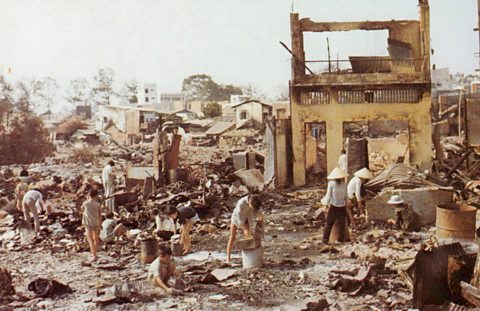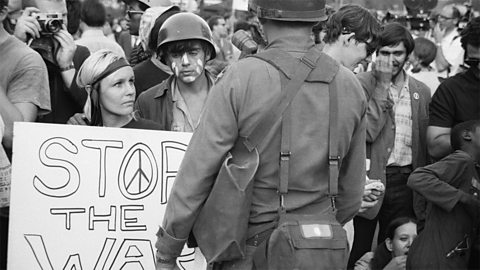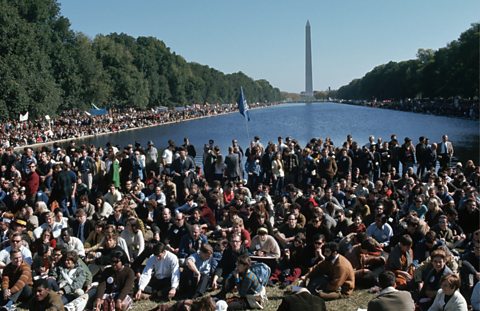Changing public opinion in the USA and abroad

As the war in Vietnam continued, opposition grew from all sections of US society. It was difficult for the US government to ignore the public outcry against the brutality, rising number of casualties, financial commitment and questionable motives for fighting in the war.
The media
The Vietnam War was the first major war to be televised and documented through the media. Images of warfare and dead or wounded American soldiers brought the war home. Additionally, photographs of children covered in napalm, burn victims and the evidence of My Lai, all shocked the American public. These brutal images destroyed the US governmentтs claim that they were fighting a war against an immoral enemy.
Protest groups

Protests came from many sections of society for varying reasons. Much of the opposition to the war was organised.
Civil rights campaigners
The Civil Rights Movement which had been fighting for the rights of black people in the US was involved in opposing the war. There were many more African-Americans conscripted, compared with whites.
Campaigners argued that as black people were being persecuted in the USA, the government had no right to demand that they fight for the тfreedomт of the Vietnamese. Muhammad Ali had his boxing title revoked as a result of his refusal to fight in the war.
Students
Many American students wanted to take a stand against the older generation. They believed they were out of touch and that the government was abusing its power. Many supported the Civil Rights Movement, while others felt it was wrong to be fighting at all.
Student opposition came to a head at Kent State University in Ohio in May, 1970. A demonstration was held after the US invaded Cambodia. During the protest four students were shot dead and nine others were wounded by the National Guard, who were trying to control the demonstration.
Draft
The Draft Resistance Movement was established to fight conscription. Over 250,000 men avoided the draft through advice given by the organization.
Between 1965 and 1968, 12,000 US casualties were reported. The Vietnam Veterans Against The War movement claimed that it was not worth the sacrifice.
Protests

There were protests from environmental groups regarding use of defoliants (toxic chemicals) to destroy the Vietnamese jungle.
Torture carried out under Operation Phoenix brought criticism from many human rights activists.
In October 1969, one of the largest protests that America has ever seen was held in Washington, with 250,000 protesting against the war.
Strain on the Government
During President Johnsonтs administration, the war was costing the US $20 million per year. The cost of training, supplying and transporting troops, as well as the cost of weapons was draining the US economy.
At home, social and economic reforms had been promised by the Johnson administration to improve employment levels, medical services and education. These reforms were not completed as money had to be diverted to the war effort.
Lack of international support
Allies of the USA gave limited support. Capitalist countries such as Britain and France were critical of the war, especially Operation Rolling Thunder.
Although set up by the USA to prevent the spread of communism in that part of the world, SEATO (The South East Asia Treaty Organisation) provided little backing.
Only Australia, New Zealand, South Korea and the Philippines provided any soldiers. Even then, only a small number actually contributed, compared to the US commitment.
The USA is a democracy, where politicians rely on the support of the masses. This meant that the continuation in the war became politically unviable.
In 1973, the US recognised it could not win and signed a peace agreement with North Vietnam. In 1975 the Vietcong finally defeated South Vietnam and the whole country became communist.
Ultimately the domino theory proved to be wrong - while Laos and Cambodia did become communist, countries like Thailand, Burma and Malaysia did not become communist.